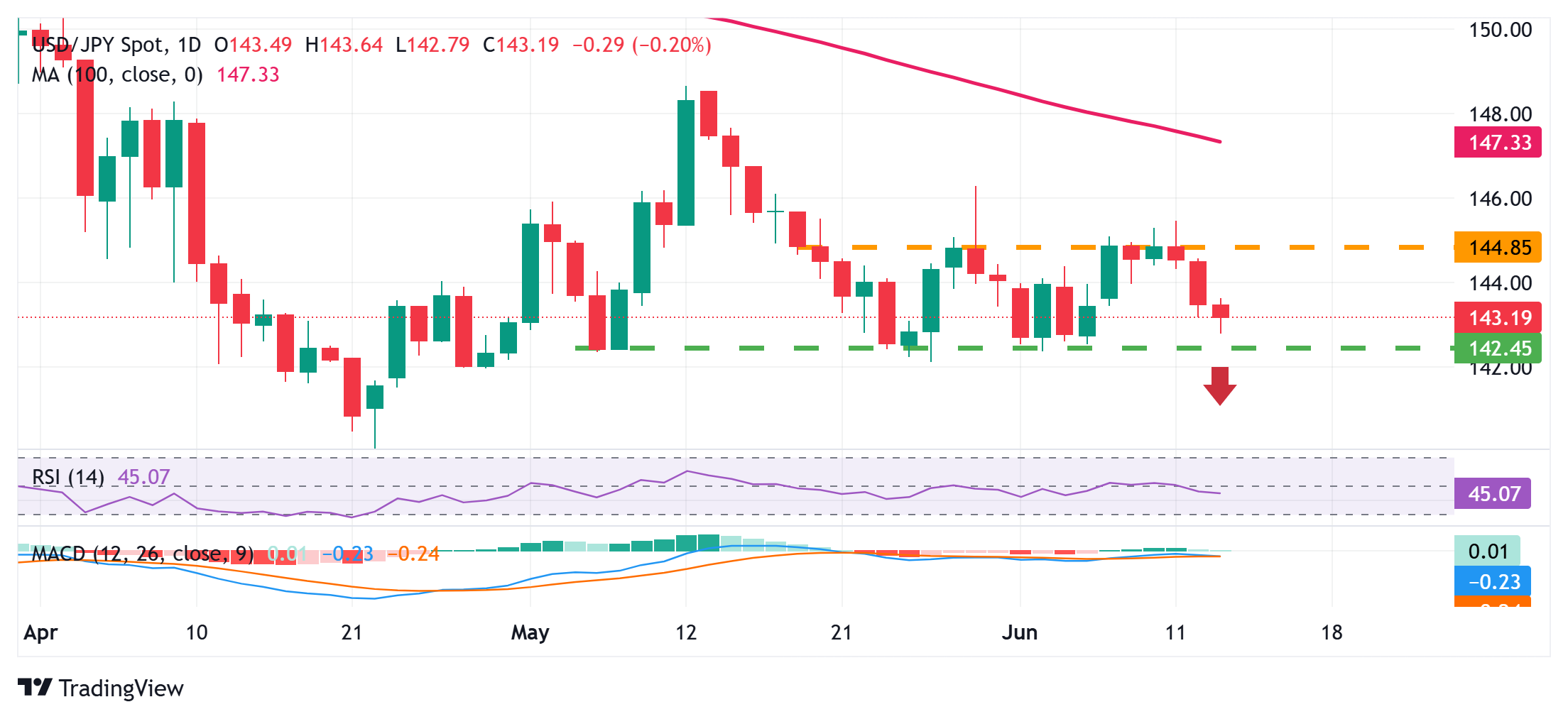
- The Japanese Yen attracts some intraday sellers, though the downside seems limited.
- Rising geopolitical tensions and trade uncertainties should benefit the safe-haven JPY.
- The divergent BoJ-Fed policy expectations could contribute to capping the USD/JPY.
The Japanese Yen (JPY) retreats sharply from over a one-week low touched against the rebounding US Dollar (USD) during the Asian session on Friday. Any meaningful JPY depreciation, however, seems elusive in the wake of rising geopolitical tensions in the Middle East, which, along with persistent trade-related uncertainties, might continue to act as a tailwind for traditional safe-haven assets.
Furthermore, the growing acceptance that the Bank of Japan (BoJ) will stick to the path toward monetary policy normalization backs the case for the emergence of some JPY dip-buyers. Meanwhile, further signs of cooling inflation in the US reaffirmed bets for an imminent rate cut by the Federal Reserve (Fed) this year. This could cap the USD recovery and benefit the lower-yielding JPY.
Japanese Yen bulls have the upper hand amid the global flight to safety
- Israel launched a pre-emptive attack against Iran. The Israeli Air Force conducted dozens of strikes across Iran, targeting nuclear and missile sites as well as military headquarters. Following the attack, Israeli Minister of Defense Israel Katz declared a special state of emergency in the country and warned that a missile and drone attack on Israel and its civilian population would occur soon.
- US Secretary of State Marco Rubio said in a statement that Israel took unilateral action and that the US is not involved in strikes against Iran. Meanwhile, Iran’s Defence Minister Aziz Nasirzadeh had threatened to strike US bases in the region if conflict erupts over its nuclear program. This raises the risk of a broader regional conflict and boosts the safe-haven Japanese Yen.
- On the trade-related front, US President Donald Trump said on Wednesday that he will set unilateral tariff rates and inform trading partners within two weeks. Moreover, Trump’s expanded steel tariffs, currently at 50%, apply to a range of household appliances, including dishwashers, washing machines, refrigerators, and more, adding a layer of uncertainty to the markets.
- A Reuters poll indicated earlier this week that a slight majority of economists expect that the Bank of Japan will forego another interest rate hike this year. Investors, however, seem convinced that the BoJ might continue to push for tighter monetary conditions and hike rates further as inflation in Japan has consistently exceeded the central bank’s 2% target for more than three years.
- In contrast, traders ramped up bets that the Federal Reserve would resume its rate-cutting cycle in September after data released on Thursday pointed to signs of cooling inflation and a potential weakening in the labor market. The US Bureau of Labour Statistics reported that the Producer Price Index remained muted in May and rose 0.1% from a month earlier, vs. a 0.2% decline in April.
- In the 12 months through May, the PPI advanced 2.6% after rising 2.5% in April. A separate report showed US Initial Weekly Jobless Claims held steady at 248K last week, while continuing claims jumped to 1.951 million, or the highest level since November 2021. This comes on top of a marginal rise in US consumer prices, backing the case for further monetary policy easing by the Fed.
- The dovish outlook drags the US Dollar to its lowest level since March 2022 during the Asian session on Friday and weighs heavily on the USD/JPY pair. Traders now look forward to the Preliminary release of the Michigan US Consumer Sentiment Index and Inflation Expectations. The focus, however, will remain on developments surrounding Trump’s trade policies and the Middle East conflict.
USD/JPY needs to clear the 144.50 hurdle before any further recovery

From a technical perspective, this week’s failures to find acceptance above the 145.00 psychological mark and the subsequent fall favor the USD/JPY bears amid negative oscillators on hourly/daily charts. However, it will still be prudent to wait for some follow-through selling below the 142.65 and the 142.35 horizontal support before positioning for deeper losses. Spot prices might then weaken below the 142.00 round figure, towards the 141.65 intermediate support en route to the sub-141.00 levels.
On the flip side, recovery beyond the Asian session peak, around the 143.50-143.55 area, is likely to confront a stiff barrier near the 144.00 mark. A sustained strength beyond the latter might trigger a short-covering move and allow the USD/JPY pair to climb to the 144.50 area en route to the 145.00 round figure. The subsequent move-up could lift spot prices to the 145.45 zone, or a two-week high touched on Wednesday.
US Dollar PRICE Today
The table below shows the percentage change of US Dollar (USD) against listed major currencies today. US Dollar was the strongest against the Australian Dollar.
| USD | EUR | GBP | JPY | CAD | AUD | NZD | CHF | |
|---|---|---|---|---|---|---|---|---|
| USD | 0.41% | 0.40% | 0.01% | 0.21% | 0.81% | 0.76% | -0.17% | |
| EUR | -0.41% | 0.03% | -0.31% | -0.14% | 0.48% | 0.32% | -0.58% | |
| GBP | -0.40% | -0.03% | -0.45% | -0.25% | 0.35% | 0.27% | -0.59% | |
| JPY | -0.01% | 0.31% | 0.45% | 0.22% | 0.81% | 0.73% | -0.18% | |
| CAD | -0.21% | 0.14% | 0.25% | -0.22% | 0.58% | 0.56% | -0.34% | |
| AUD | -0.81% | -0.48% | -0.35% | -0.81% | -0.58% | -0.08% | -0.96% | |
| NZD | -0.76% | -0.32% | -0.27% | -0.73% | -0.56% | 0.08% | -0.88% | |
| CHF | 0.17% | 0.58% | 0.59% | 0.18% | 0.34% | 0.96% | 0.88% |
The heat map shows percentage changes of major currencies against each other. The base currency is picked from the left column, while the quote currency is picked from the top row. For example, if you pick the US Dollar from the left column and move along the horizontal line to the Japanese Yen, the percentage change displayed in the box will represent USD (base)/JPY (quote).
Information on these pages contains forward-looking statements that involve risks and uncertainties. Markets and instruments profiled on this page are for informational purposes only and should not in any way come across as a recommendation to buy or sell in these assets. You should do your own thorough research before making any investment decisions. FXStreet does not in any way guarantee that this information is free from mistakes, errors, or material misstatements. It also does not guarantee that this information is of a timely nature. Investing in Open Markets involves a great deal of risk, including the loss of all or a portion of your investment, as well as emotional distress. All risks, losses and costs associated with investing, including total loss of principal, are your responsibility. The views and opinions expressed in this article are those of the authors and do not necessarily reflect the official policy or position of FXStreet nor its advertisers. The author will not be held responsible for information that is found at the end of links posted on this page.
If not otherwise explicitly mentioned in the body of the article, at the time of writing, the author has no position in any stock mentioned in this article and no business relationship with any company mentioned. The author has not received compensation for writing this article, other than from FXStreet.
FXStreet and the author do not provide personalized recommendations. The author makes no representations as to the accuracy, completeness, or suitability of this information. FXStreet and the author will not be liable for any errors, omissions or any losses, injuries or damages arising from this information and its display or use. Errors and omissions excepted.
The author and FXStreet are not registered investment advisors and nothing in this article is intended to be investment advice.







